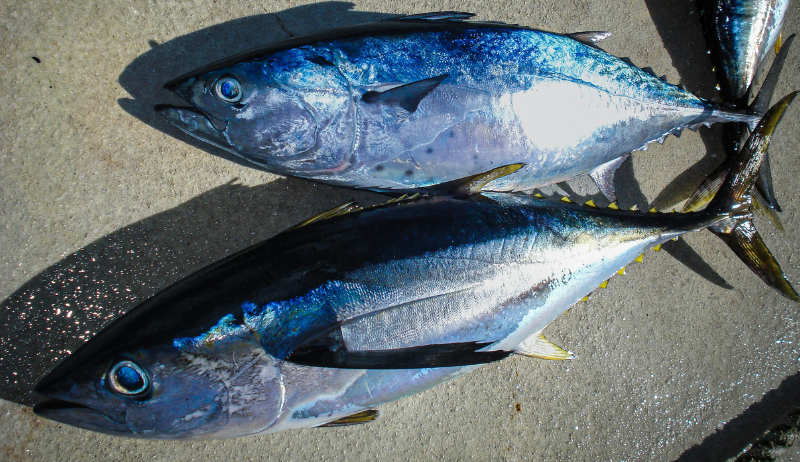How to Maintain the Freshness of Skipjack Tuna
November 15, 2024

How to Maintain the Freshness of Skipjack Tuna
Skipjack tuna (Katsuwonus pelamis) is one of the most popular and widely consumed tuna species in the world. Known for its rich flavor and versatility in dishes ranging from sushi to canned tuna, its freshness is critical to its flavor, texture, and overall quality. Whether you're a fisherman, supplier, or consumer, understanding the best methods to preserve skipjack tuna freshness is essential to ensure it reaches the market in optimal condition.
This article will explore the best practices for keeping skipjack tuna fresh, from handling and storage to transportation and preservation techniques. By following these methods, you can help maintain the high quality of skipjack tuna, ensuring it retains its flavor, texture, and nutritional value.
Factors That Affect Skipjack Tuna Freshness
The freshness of skipjack tuna can be compromised by a variety of factors, including time, temperature, handling, and exposure to air. Skipjack tuna is a perishable product, so it requires immediate attention once caught to prevent deterioration. The primary factors that affect its freshness include:
- Temperature: Tuna is highly sensitive to temperature changes. If the fish is not chilled or frozen properly, its freshness will quickly decline, leading to loss of quality.
- Time: The longer tuna is stored or exposed to unfavorable conditions, the more likely it is to lose its freshness. Proper handling and quick processing are key to preserving quality.
- Exposure to Oxygen: Tuna, like all fish, is prone to oxidation. Prolonged exposure to oxygen can cause discoloration and off-flavors, which compromise the overall quality of the fish.
- Physical Damage: Any physical damage to the fish during capture or transport, such as bruising or punctures, can lead to faster deterioration and spoilage.
Best Practices for Maintaining Skipjack Tuna Freshness
1. Immediate Icing After Catch
The first step in maintaining the freshness of skipjack tuna is to immediately ice the fish after it is caught. The cooling process should begin as soon as possible to slow down bacterial growth and preserve the tuna's quality. Fishermen often use large quantities of ice to keep the fish chilled on board the vessel.
If fresh water is used, make sure the ice is clean and free from contaminants. If seawater is used, be cautious of the temperature fluctuations. The general rule is to keep the fish at a temperature close to 0°C (32°F) to slow down deterioration processes.
2. Proper Handling and Processing
Proper handling during the catching and processing stages plays a vital role in maintaining the freshness of skipjack tuna. It's essential to avoid any physical damage to the fish. For instance, when the tuna is being transferred from the boat to storage, it should be handled gently and not tossed or dropped.
Once the tuna is brought on board, it should be cleaned and gutted as soon as possible to reduce the risk of bacterial growth. The quicker the tuna is cleaned and processed, the less chance there is for contamination.
3. Freezing for Long-Term Freshness
If the skipjack tuna will be stored for a longer period before reaching the market, freezing is one of the most effective methods to maintain its freshness. The best way to freeze tuna is by using rapid freezing techniques, which lock in the fish’s texture, color, and flavor. Slow freezing can cause the formation of ice crystals, which damage the cell structure of the tuna and degrade its quality.
For optimum results, tuna should be frozen as soon as it is cleaned and processed, ideally within a few hours after capture. The fish should be wrapped tightly in plastic or vacuum-sealed bags to prevent freezer burn and the loss of moisture.
4. Use of Vacuum Sealing for Storage
Vacuum sealing is another effective method to maintain the freshness of skipjack tuna, particularly when it's stored in the refrigerator or freezer. By removing air from the packaging, vacuum sealing prevents oxidation and the growth of bacteria, which are two main contributors to spoilage.
Vacuum-sealed skipjack tuna can be stored for several weeks in the freezer while retaining its freshness. When thawed properly, the fish retains much of its original flavor and texture. If the tuna is intended for long-term storage, it's best to freeze it immediately after processing and vacuum sealing.
5. Cold Chain Management for Transport
Cold chain management refers to the process of keeping products at the correct temperature during transport and storage to maintain their quality. For skipjack tuna, this means keeping the fish at a constant temperature from the moment it is caught until it reaches its final destination.
Transporting skipjack tuna in refrigerated containers or trucks is essential to ensure the fish remains at the proper temperature throughout its journey. Temperature monitoring systems should be in place to detect any temperature fluctuations that could affect the fish's freshness.
For air transport, tuna should be packed with sufficient ice or dry ice to maintain its freshness during the flight. Upon arrival at the destination, the fish should be immediately placed in cold storage until it is ready to be processed or consumed.
6. Proper Thawing Techniques
When it comes time to thaw frozen skipjack tuna, it's essential to do so slowly and safely to preserve its texture and flavor. Rapid thawing, such as using hot water or microwaving, can cause the tuna to lose moisture and flavor.
The best way to thaw skipjack tuna is in the refrigerator overnight, allowing it to slowly return to a temperature just above freezing. If the tuna needs to be thawed more quickly, it can be placed in a sealed plastic bag and immersed in cold water. However, the water should not exceed 40°F (4°C) to prevent the growth of harmful bacteria.
Common Mistakes to Avoid When Storing Skipjack Tuna
- Leaving Tuna at Room Temperature: Never leave skipjack tuna at room temperature for extended periods, as this can lead to rapid bacterial growth and spoilage.
- Improper Freezing: Slow freezing or freezing tuna without proper sealing can cause quality loss, including freezer burn and texture degradation.
- Exposing Tuna to Direct Sunlight: Avoid leaving skipjack tuna exposed to sunlight, as this can cause the fish to warm up, leading to spoilage.
- Thawing Improperly: Never thaw skipjack tuna at room temperature, as this can cause bacteria to grow rapidly and negatively impact the fish’s quality.
Conclusion
Maintaining the freshness of skipjack tuna is essential for preserving its quality and ensuring it reaches consumers in the best possible condition. By following best practices for handling, storage, freezing, and transportation, you can prolong the shelf life of skipjack tuna and retain its rich flavor and nutritional value. Whether you're a fisherman, distributor, or consumer, understanding these techniques will help you maintain the high standards of this prized seafood.

 English
English Chinese
Chinese